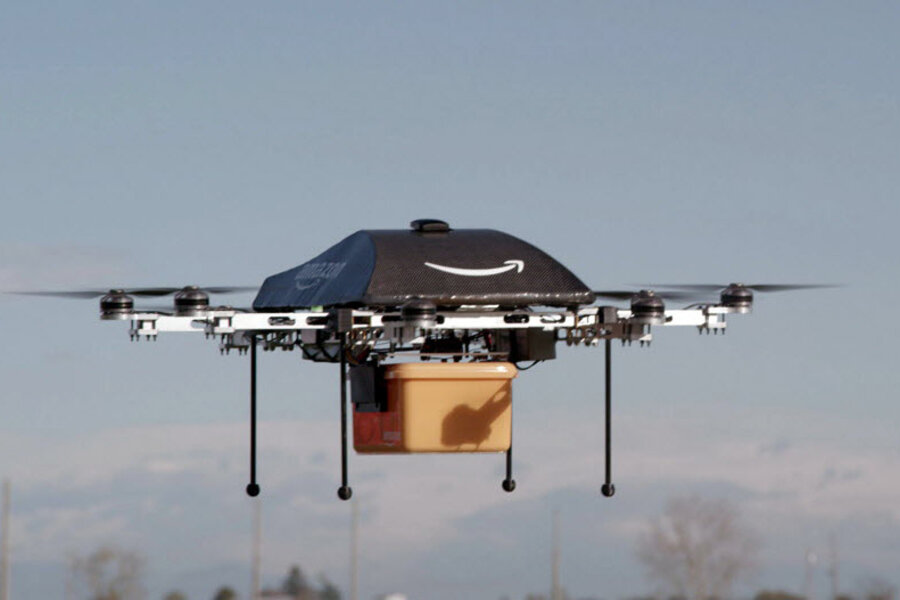Why Amazon's promise of 30-minute deliveries by drone is still in limbo
Loading...
Sometime in the near future, Amazon is promising, the company's drone service will be able to make package deliveries in 30 minutes or less.
In a slightly tongue-in-cheek ad unveiled over the weekend, an Amazon Prime Air drone delivers a new pair of soccer shoes to a little girl in 30 minutes, after rising steadily into the sky and flying over an immaculate countryside.
“In time, they’ll be a whole family of Amazon drones, different designs for different environments. This one can fly for fifty miles and it knows what’s happening around it,” intones the British TV host Jeremy Clarkson, describing the drone’s “sense and avoid” technology, which uses sensors to anticipate potential obstacles as it flies.
On the ground, the picture is somewhat messier, as rules governing how drones should operate are inching forward in the US and internationally.
A Federal Aviation Administration (FAA) task force last week unveiled proposed regulations that would require hobbyists who wish to fly unmanned aircraft larger than half an inch but less than 55 pounds to register with the FAA.
Currently, such aircraft are required to fly below 400 feet and remain in the operator’s line of sight, although commercial drone operators can apply for an exemption from the regulator, with more than 2,000 exemptions granted so far.
The drone task force, which includes representatives of several companies currently exploring drone technology, including Amazon, Google, and Walmart, aims to clarify the distinction between commercial drones and hobbyists while keeping both out of the way of manned flights.
But the strict recommendations were opposed by model aircraft operators who participated in the task force.
“Unfortunately the task force recommendations may ultimately prove untenable by requiring the registration of smaller devices that are essentially toys and do not represent safety concerns,” Dave Mathewson, executive director of the Academy of Model Aeronautics, which represents 180,000 hobbyists, told USA Today.
If the regulations are adopted, drone owners would be required to provide their names and addresses, an optional phone number or e-mail, along with marking the drones with a unique number to identify them. FAA officials have said they would hope to create a drone registry by December 20.
In Germany, regulators are also moving forward with proposals to require both commercial and hobbyist drones that weigh more than 0.5 kilogram (1.1 pound) to carry a license plate that helps identify the operator.
The proposals would also prohibit hobbyist flights over 328 feet and beyond the pilot's line of sight. Commercial drone operators would also have to pass a test showing their flying skills and knowledge of relevant laws, reports RoboticsTrends.
The regulations come about a year after the post carrier DHL introduced a pilot program to deliver medicine by a small rotary-blade “parcelcopter” drone to a remote island on Germany’s North Sea. The program began delivering medications ordered from a local pharmacy to the island of Juist on a regular basis last September, the company said in a statement. DHL said it didn't plan to expand the program to make regular deliveries using the drones, noting that the initial flights would be automatic but “closely monitored” by a human operator.
The push for American regulation comes in the wake of several near-miss collisions with airplanes, along with instances of drones flying over restricted airspace, including the White House. As drones become more popular, the potential for collisions — which could be more dangerous than hitting a bird, regulators say — could increase. About 700,000 drones are expected to ship in the US this year, an increase of 63 percent from last year, according to the Consumer Technology Association.
“The problem is that encounters with drones usually take place during the most critical phases of a flight, such as during take-off or landing when a drone strike could have potentially devastating consequences,” Philip von Schoeppenthau, Secretary General of the European Cockpit Association told Reuters in August.
Amazon has proposed its own regulations to solve those problems. It would create a “high speed transit” area between 200 and 400 feet for “well-equipped” automated vehicles that would fly beyond the operator’s line of sight, while limiting local videography and and inspection flights at slower speeds to 200 feet or under and creating designated “low-risk” airspaces for hobbyist flights. Above 400 to 500 feet would be a permanent no-fly zone, the company said in a proposal on its website.
The company has been building and testing its drones in several parts of the world, including the UK, Israel, and Canada, in addition to the US.
But alluding to still-fraught regulatory climate, Amazon notes, “Putting Prime Air into service will take some time, but we will deploy when we have the regulatory support needed to realize our vision.”







